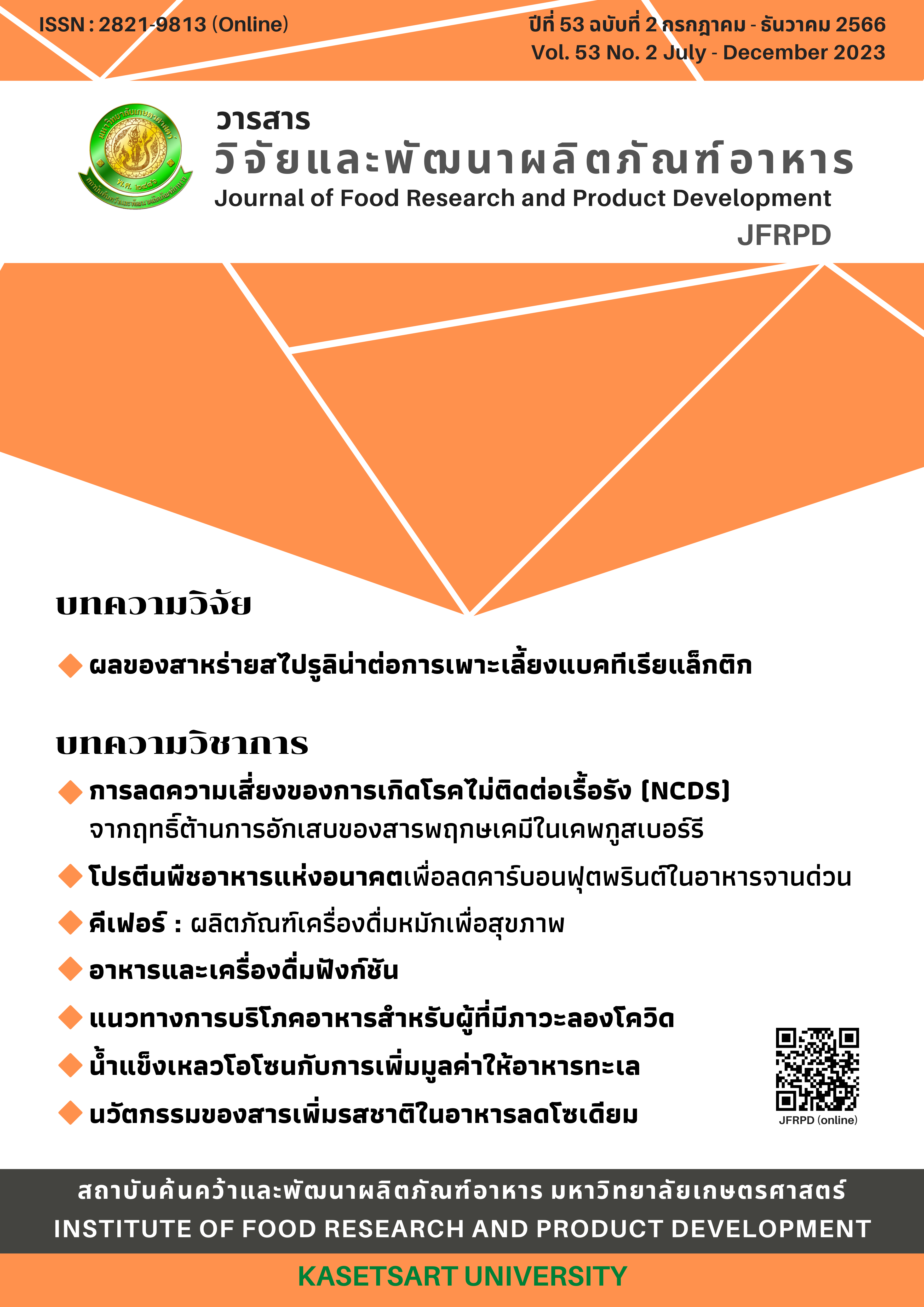การลดความเสี่ยงของการเกิดโรคไม่ติดต่อเรื้อรัง (NCDs) จากฤทธิ์ต้านการอักเสบของสารพฤกษเคมีในเคพกูสเบอร์รี Reducing the risk of Noncommunicable diseases (NCDs) through anti-inflammatory activity of phytochemicals in cape gooseberry
##plugins.themes.bootstrap3.article.main##
摘要
Noncommunicable diseases (NCDs) caused by heart disease, cancer, chronic respiratory, and neurological disease was identified as the leading causes of deaths worldwide as well as in Thailand. The progression of NCDs is mostly directed toward chronic inflammation, the overproduction of inflammatory mediators, and immunodeficiency. The utilization of phytochemicals from plants becomes a great opportunity for health prevention. Various plants can be used as sources of new bioactive compounds. Cape gooseberry has been grown in Thailand for 40 years with the improvement of varieties. Phenolic compounds and flavonoids, which are mainly phytochemicals in cape gooseberry, exhibit strong anti-inflammatory and immune system enhancement properties. Cape gooseberry shows the advantage of suppressing inflammation, which can reduce the risk of NCDs and their severity.
Keywords : cape gooseberry, noncommunicable diseases (NCDs), chronic inflammation, anti-inflammatory, phytochemicals
บทคัดย่อ
ความรุนแรงของโรคไม่ติดต่อเรื้อรัง เช่น โรคหัวใจและหลอดเลือด มะเร็ง โรคเกี่ยวกับระบบทางเดินหายใจและระบบสมอง เป็นต้น อันเป็นสาเหตุหลักของการเสียชีวิตของประชากรไทยและประชากรโลก โดยภาวะอักเสบเรื้อรังในระดับเซลล์ การสร้างสารตัวกลางจำนวนมาก และการทำงานของภูมิคุ้มกันที่ผิดปกติ ถือเป็นปัจจัยสำคัญที่ทำให้อาการของโรคในกลุ่มนี้มีความรุนแรงขึ้น การใช้ประโยชน์เชิงสุขภาพจากพืชชนิดต่าง ๆ เป็นแนวทางที่ได้รับความสนใจ ทั้งในแง่การค้นหาสารพฤกษเคมีชนิดใหม่ หรือใช้พืชชนิดต่าง ๆ เป็นแหล่งของสารออกฤทธิ์ทางชีวภาพ ในส่วนของเคพกูสเบอร์รีนั้น ถือเป็นไม้ผลที่ได้รับการคัดเลือกและพัฒนาสายพันธุ์ให้มีความเหมาะสมในการเพาะปลูกในประเทศไทยมายาวนานกว่า 40 ปี และยังเป็นแหล่งของสารพฤกษเคมีหลายชนิด โดยเฉพาะอย่างยิ่งสารประกอบฟีนอลิกและฟลาโวนอยด์ที่มีฤทธิ์ต้านการอักเสบและส่งเสริมระบบภูมิคุ้มกันที่ดี จึงสามารถใช้ประโยชน์จากเคพกูสเบอร์รีในการลดระดับการอักเสบและจำกัดการอักเสบให้อยู่ในภาวะที่เหมาะสม ช่วยลดความเสี่ยงในการเกิดโรคไม่ติดต่อเรื้อรังจากจุดเริ่มต้น และยังลดความรุนแรงของโรคได้อีกด้วย
คำสำคัญ : เคพกูสเบอร์รี โรคไม่ติดต่อเรื้อรัง การอักเสบเรื้อรัง ฤทธิ์ต้านการอักเสบ สารพฤกษเคมี
##plugins.generic.usageStats.downloads##
##plugins.themes.bootstrap3.article.details##
参考
World health Organization (WHO). Noncommunicable Diseases Progress Monitor 2022. 2022; https://www.who.int/publications/i/item/9789240047761
Medzhitov R. Inflammation 2010: New adventures of an old flame. Cell. 2010;140:771-6.
Lon H-K, Liu D, Jusko WJ. Pharmacokinetic/pharmacodynamic modeling in inflammation. Crit Rev in Biomed Eng. 2012;40:295-312.
Power O, Jakeman P, FitzGerald R. Antioxidative peptides: enzymatic production, in vitro and in vivo antioxidant activity and potential applications of milk-derived antioxidative peptides. Amino acids. 2013;44:797-820.
Abbas A, Lichtman AH, Pillai S. Cellular and Molecular Immunology. Elsevier, Philadelphia, PA. 2015.
Lordan R, Tsoupras A, Zabetakis I. Chapter 2 - Inflammation, Editor(s): Ioannis Zabetakis I. in The Impact of Nutrition and Statins on Cardiovascular Diseases, Academic Press, 2019;pp. 23-51.
Singh A, Holvoet S, Mercenier A. Dietary polyphenols in the prevention and treatment of allergic diseased. Clin Exp Allergy. 2011;41:1346-59.
Mokhtari T, Hassani F, Ghaffari N, Ebrahimi B, Yaramadi A, Hassanzadeh G. COVID-19 and multiorgan failure: A narrative review on potential mechanisms. J Mol Histol. 2020;51:613–28.
Yang L, Xie X, Tu Z, Fu J, Xu D, Zhou Y. The signal pathways and treatment of cytokine storm in COVID-19. Signal Transduction and Targeted Therapy. 2021;6:255.
Galan M, Vigon L, Fuertes D, Murciano-Anton MA, Casado G, Domínguez-Mateo S. Persistent overactive cytotoxic immune response in a spanish cohort of individuals with Long-COVID: Identification of diagnostic biomarkers. Front Immunol. 2022;13:1129.
Santasup C, Chaiwon F, Ueangsawat K. Improvement of water-saving and fertilize use efficiency for fruit orchard in highland area. in Research Report. Chiang Mai; Highland Research and Development institute (Public Organization). 2018; 111 p. [in Thai]
Mazova N, Popova V, Stoyanova A. Phytochemical composition and biological activity of Physalis spp.: A mini-review. FSAB. 2020;3:56-70.
Ramadan MF. Bioactive phytochemicals, nutritional value, and functional properties of cape gooseberry (Physalis peruviana): an overview. Food Res Int. 2011;44:1830-36
Olivares-Tenorio M-L, Dekker M, Verkerk R, van Boekel MAJS. Health-promoting compounds in cape gooseberry (Physalis peruviana L.): Review from a supply chain perspective. Trends Food Sci Technol. 2016;57:83-92.
Martínez W, Ospina LF, Granados D, Delgado G. In vitro studies on the relationship between the anti-inflammatory activity of Physalis peruviana extracts and the phagocytic process. Immunopharmacol. Immunotoxicol. 2010;32(1):63-73.
Ahmed LA. Renoprotective effect of egyptian cape gooseberry fruit (Physalis peruviana L.) against acute renal injury in rats. Sci World J. 2014;273870.
El-Beltagi HS, Mohamed HI, Safwat G, Gamal M, Megahed BMH. Chemical composition and biological activity of Physalis peruviana L. Gesunde Pflanzen. 2019;71(2):113-22.
Li X, Zhoa J, Yang M, Liu Y, Li Z, Li R, Li X, Li N, Xu Q, Khan IK, Yang S. Physalins and withanolides from the fruits of Physalis alkekengi L. var. franchetii (Mast.) Makino and the inhibitory activities against human tumor cells. Phytochem lett. 2014;10:95-100.
Jang SH, Lim JW, Kim H. Beta-carotene inhibits Helicobacter pylori–induced expression of inducible nitric oxide synthase and cyclooxygenase-2 in human gastric epithelial AGS cells. J Physiol Pharmacol. 2019;60:131-7.
Aung HH, Vasu VT, Valacchi G, Corbacho AM, Kota RS, Lim Y, Obermueller-Jevic UC, Packer L, Cross CE, Gohil K. Effects of dietary carotenoids on mouse lung genomic profiles and their modulatory effects on short-term cigarette smoke exposures. Genes Nutr. 2009;4(1):23-39.
Rop O, Mlcek J, Jurikova T, Valsikova M. Bioactive content and antioxidant capacity of Cape gooseberry fruit. Cent Eur J Biol. 2012;7:672-9.
Bravo K, Sepulveda-Ortega S, Lara-Guzman O, Navas-Arboleda A. Influence of cultivar and ripening time on bioactive compounds and antioxidant properties in Cape gooseberry (Physalis peruviana L.). J Sci Food Agric. 2015;95:1562-9.
Balasundram N, Sundram K, Samman S. Phenolic compounds in plants and agri-industrial by-products: Antioxidant activity, occurrence, and potential uses. Food Chem. 2006;99:191-203.
Ma X, Wu H, Liu L, Yao Q, Wang S, Zhan R, Xing S, Zhou Y. Polyphenolic compounds and antioxidant properties in mango fruits. Sci Hortic. 2011;129:102-7.
Licodiedoff S, Koslowski LAD, Ribani RH. Flavonols and antioxidant activity of Physalis peruviana L. fruit at two maturity stages. Acta Sci Technol. 2013;35:393-9.
Wu SJ, Tsai JY, Chang SP, Lin DL, Wang SS, Huang SN, Ng LT. Supercritical carbon dioxide extract exhibits enhanced antioxidant and anti-inflammatory activities of Physalis peruviana. J Ethnopharmacol. 2006;108:407-13.

